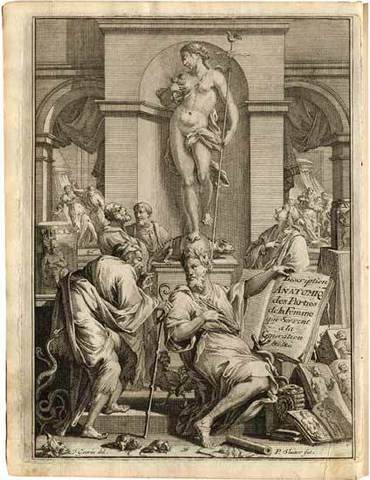PALFIJN, Jan (1650–1730) [Palfin or Palfyn]
Description anatomique des parties de la femme, qui servent à la generation; avec un traite des monstres, de leur causes, de leur nature, & de leur differences: et une description anatomique, de la dispositions suprenante de quelques parties externes, & internes de deux enfans nes dans la ville de Gand, capital de Flanders le 28. Avril 1703, &c. &c. Lesquels ouvrages on peut considerer comme une suite de l’accouchement des femmes par Monsr. Mauriceau.
Leiden, Bastiaan Schouten, 1708.














First edition of Palfijn’s French version of Licetus’ book of monsters and Swammerdam’s Miraculum naturæ, and his own on the monster twins of Gent, all richly illustrated with copperplates of remarkable monsters (Licetus) and of the female reproductive organs (Swammerdam). In April, 1703, in the city of Gent, twins were born united at the lower part of their bodies which created such a stir that Jan Palfijn on account of his great reputation as an anatomist was selected to dissect them before the magistrate, the directors of the College of Medicine and the principal practitioners. A month later another monster was born in Gent, also dissected by Palfijn, in which were found an imperforate anus and a vagina together with a double uterus. Palfijn was requested to make a report of his findings, which was published in Flemish in 1703 together with a treatise on the circulation of the blood in the foetus. In 1708 Palfijn published a French edition illustrated with 4 folding plates issued at the end of his book on the anatomy of the female reproductive organs and on monsters, which in fact being Palfijn’s rendering into French of Swammerdam’s Miraculum naturæ (1672) with 3 large folding plates, and Gerhard Blasius’enlarged edtion of Licetus’ remarkable work on monsters (1665) including the Appendix on new and rare monsters, illustrated with 68 half-page engravings in the text and 4 plates. The three folding plates of the female organs of generation as well as the monster-plates were reproduced from the copperplates of the original works. The thick volume was meant to form a supplement to Mauriceau’s standard text-book on midwifery.
Collation: Pp (6), 128, with 3 large folding plates (Parties de la Femme); Traite des Monstres: pp (16), 366, with 4 plates and 68 half-page engravings in the text; Description de Deux Enfans: pp 72, with 4 folding plates. Engraved frontispiece. Title printed in red and black.
Binding: Contemporary calf, richly gilt spine. Marbled endpapers.
Provenance: Till SLS af C. Haeggström, a physician practicing at the mineral spring of the Stora Mosebacke garden in Stockholm.
References: J. B. Stein ‘Jan Palfyn’ in Medical Record, 83, No. 2, pp 47-55; Cutter & Viets, 56-58, 192. Hagelin, The Byrth of Mankynde or the Womans Booke, 90-93. SLS 500 Waller 7064.